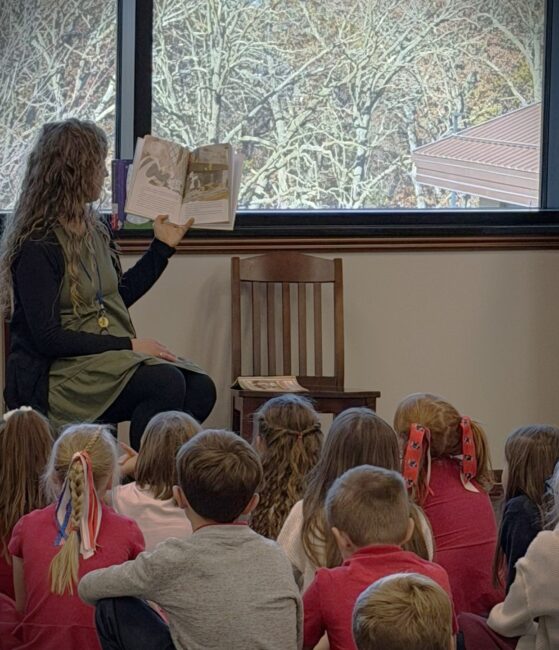
I do two main types of children’s book reading. I read to my own two children, currently ages 7 and 10. And I read to a whole classes of children, ages 3 to 11. They can be fairly different experiences. For this post, I’ll call the first one “lap-read alouds” and the second “library-time read-alouds.”

During “library read-alouds”, I’m reading to a larger group of students who are further away from the illustrations. The words need to carry more of the weight than the illustrations, and I try to minimize students interrupting me to help keep everyone engaged.
During “lap-time reading” at home, I’m reading to a small enough group where the children are within three feet of the book and relatively free to interrupt me with questions and comments. These children can physically point to something in an illustration. (And for the record, most of the reading I actually do at this point is not with a child on my lap but is at the dinner table, while my children slowly finish their vegetables.)

In my experience, nearly all “library read-aloud books” make for great “lap read-aloud books.” But the opposite is not always true: there are books my children loved when I read them with them at home that fell flat at library time.
Why? Here’s my theory: At home, or in a very small group setting, children can appreciate books with intricate pictures and complicated plots sooner than some of those same children would in a large group setting. You can stop when the child starts to squirm, making sure they understand, or abandon the book altogether if it’s not the right time. There are also times you want a quiet book to help the child calm down.
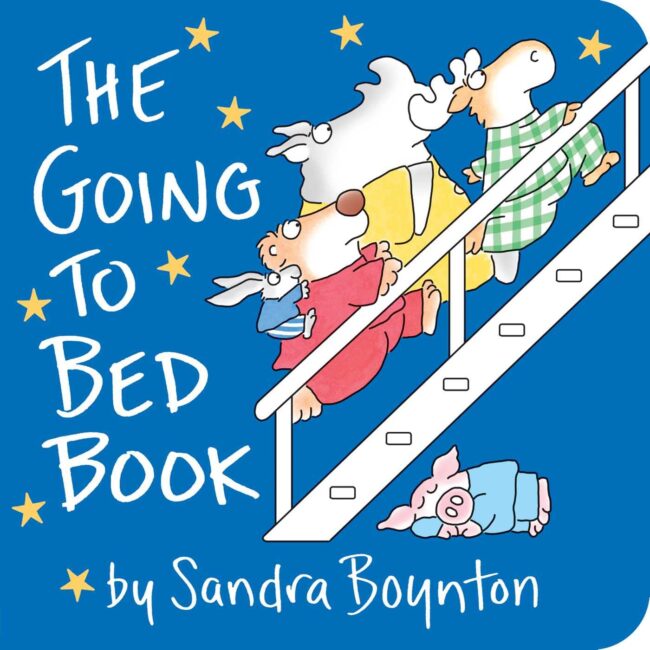
In large group settings, it is harder to do those things. You have a wide variety of students who have different experiences being read to, different attention spans, and generally, there are more opportunities for distractions. While you can stop and explain things if the whole class seems lost, you don’t want to abandon a book in the middle of library read-aloud time. (Hopefully you’ve read the book before, so you know it’s appropriate! Always read the book through yourself before library time!)
I have found the books that I put on the lists for my own kids work better for classes of students a year older. So the books my children loved at age four, worked well for 5K-Kindergarten classes with students ages five and six.

For library whole class read alouds, I try to aim for books l think of as “ripe peach books.” Books can be a lot like food. There are fun, gimmicky books that are like candy. And there are classic, rich vocabulary books that are more like roasted broccoli. But a ripe peach is sweet and healthy.
Almost everyone loves a really perfectly ripe peach picked at just the right time.
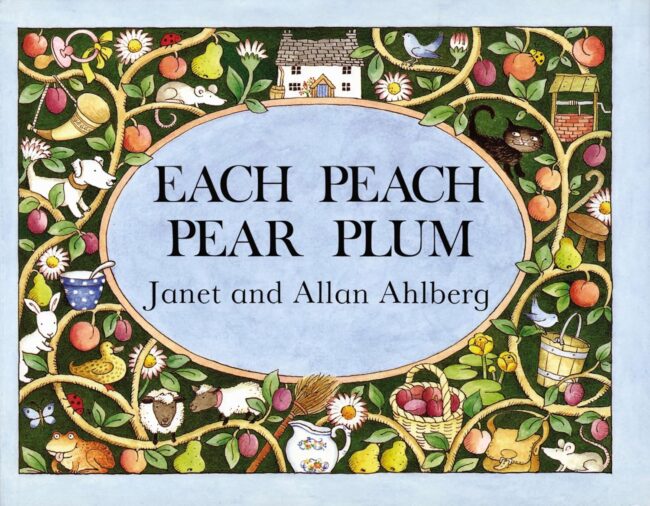
I aim for my library read-alouds to be engaging, but substantive, and the right book for just the right age group.
I only get to read roughly 30 books a year for a class, so I want each of those books to be great. I also want to build trust with a class by reading “home-run” books at the beginning of the year.

With my own kids, we read enough books that there is room for junky, fun twaddle “candy” books once in a while. Of course, my kids are delighted by these, while I tolerate them. At home, we also read a good number of books that are “the meat and vegetables,” good-for-them books that stretch their attention spans and expand their vocabulary and worldview. I tend to love these books, and my kids find them “good enough.” But for library read-alouds, I try to stay in the zone of “perfectly ripe peaches” that everyone loves.

I have arranged these 75 books below roughly by age group. The youngest children will enjoy the first books on the list. (Roughly the first 15 books can work beginning in 3K. Three-year-olds grow a lot, so by the end of 3K they really can sit through much longer books up to # 25 ).
The books in the middle of the list are pretty universally loved by all elementary school children. (Roughly books number 20 to 60) The last 25 books often work better for older classes with longer attention spans. (But I have had quiet, small first-grade classes, love books that didn’t work for big, rowdy 3rd-grade classes. So each group can be different.)
If you try a book and halfway through, your students lose interest, next time try for books earlier in the list. For the youngest grades, I usually read two books and sing and do a few nursery rhymes between them. Also, having a globe or atlas available for the older students helps you to point out where a book takes place.
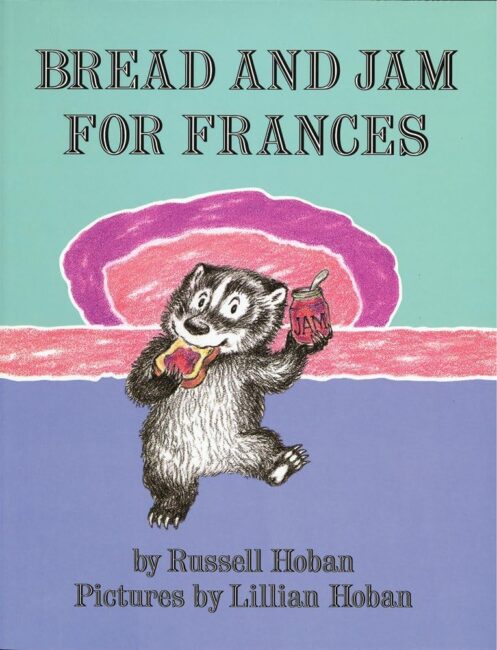
*Note: These books are not strictly in order of difficulty and length. For example, Bread and Jam for Frances is a much longer book than Real Cowboys. But I found that very young groups of 4-year-old children LOVE Frances‘ long tale of picky eating. (And older children as well, it really is a crowd favorite!) Real Cowboys, on the other hand, is quiet and meditative, and even though there aren’t many words, it’s not a book that I’ve found works well for large groups of younger children. (I think it could work if you were doing a cowboy unit, or wanted a book to read during 4K rest time, but I tend to pick fairly high-energy books for library times.) This list is based on my actual experience of reading these books to class groups, but your experience may vary!
75 of the Best Library-Time Read-Aloud Picture Books — Arranged by Target Age Group
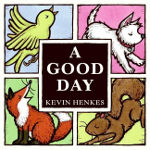 A Good Day by Kevin Henkes (3K+)
A Good Day by Kevin Henkes (3K+) Jesse Bear, What Will You Wear? by Nancy White Carlstrom and illustrated by Bruce Degen (3K+)
Jesse Bear, What Will You Wear? by Nancy White Carlstrom and illustrated by Bruce Degen (3K+)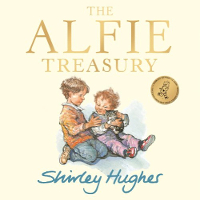 Alfie Gets in First, by Shirley Hughes (Also Bobbo Goes to School)( 3K+)
Alfie Gets in First, by Shirley Hughes (Also Bobbo Goes to School)( 3K+) Ten Little Rubber Ducks by Erik Carle (3K+)
Ten Little Rubber Ducks by Erik Carle (3K+) Play With Me by Marie Hall Ets (3K+)
Play With Me by Marie Hall Ets (3K+) Llama Llama Red Pajama by Anna Dewdney (3K+)
Llama Llama Red Pajama by Anna Dewdney (3K+) Hand, Hand, Fingers, Thumb by Al Perkins and illustrated by Eric Gurney (3K+)
Hand, Hand, Fingers, Thumb by Al Perkins and illustrated by Eric Gurney (3K+)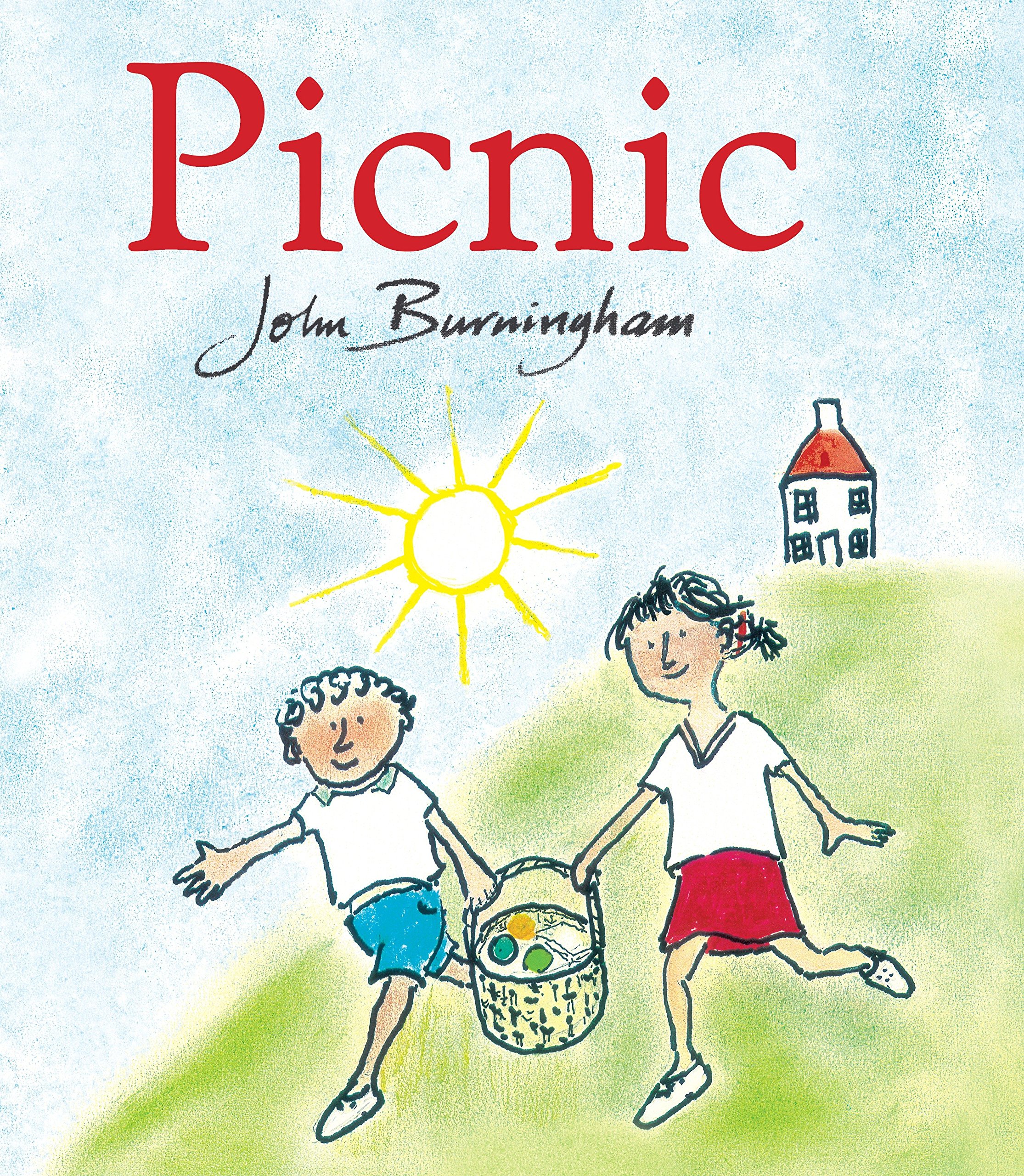 Picnic by John Burningham (3K+)
Picnic by John Burningham (3K+) Freight Train by Donald Crews (3K+)
Freight Train by Donald Crews (3K+)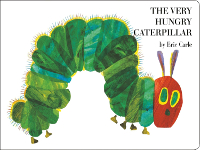 The Very Hungry Caterpillar by by Eric Carle (3K+)
The Very Hungry Caterpillar by by Eric Carle (3K+) Big Sarah’s Little Boots by Paulette Bourgeois and Brenda Clark (3K+)
Big Sarah’s Little Boots by Paulette Bourgeois and Brenda Clark (3K+) Drummer Hoff by Barbara Emberly and illustrated by Ed Emberley (and other nursery rhymes like Tomie de Paola’s First Mother Goose. Usually, 4 or 5 individual rhymes are enough for 3K. Or try to start every library time with 3 and then read a longer story.) (3K+)
Drummer Hoff by Barbara Emberly and illustrated by Ed Emberley (and other nursery rhymes like Tomie de Paola’s First Mother Goose. Usually, 4 or 5 individual rhymes are enough for 3K. Or try to start every library time with 3 and then read a longer story.) (3K+) Goodnight, Goodnight Construction Site, by Sherri Duskey Rinker and illustrated by Tom LichtenheldTom Lichtenheld (3K+)
Goodnight, Goodnight Construction Site, by Sherri Duskey Rinker and illustrated by Tom LichtenheldTom Lichtenheld (3K+) The Tale of Peter Rabbit by Beatrix Potter (3K+)
The Tale of Peter Rabbit by Beatrix Potter (3K+) Mighty Dads by Joan Holub illustrated by James Dean (3K+)
Mighty Dads by Joan Holub illustrated by James Dean (3K+) Corduroy by Don Freeman (3K+)
Corduroy by Don Freeman (3K+) Caps for Sale A Tale of a Peddler, Some Monkeys, and Their Monkey Business by Esphyr Slobodkina (3K+) This is often the first book I pick to read to the youngest classes!
Caps for Sale A Tale of a Peddler, Some Monkeys, and Their Monkey Business by Esphyr Slobodkina (3K+) This is often the first book I pick to read to the youngest classes! Knuffle Bunny Free by Mo Williams (4K+)
Knuffle Bunny Free by Mo Williams (4K+) King Bidgood’s in the Bathtub by Audrey Wood and illustrated by Don Wood (also Napping House) (4K+)
King Bidgood’s in the Bathtub by Audrey Wood and illustrated by Don Wood (also Napping House) (4K+) The Monster at the End of This Book by Jon Stone and illustrated by Michael Smollin (4K+)
The Monster at the End of This Book by Jon Stone and illustrated by Michael Smollin (4K+) Blueberries for Sal by Robert McCloskey (4K+) I remember being in the library and having this read to me in preschool in the mountains of southern California!
Blueberries for Sal by Robert McCloskey (4K+) I remember being in the library and having this read to me in preschool in the mountains of southern California! McDuff Moves In by Rosemary Wells and Susan Jeffers (4K+)
McDuff Moves In by Rosemary Wells and Susan Jeffers (4K+) The Snowy Day by Ezra Jack Keats (4K+)
The Snowy Day by Ezra Jack Keats (4K+) Make Way For Ducklings by Robert McCloskey (4K+)
Make Way For Ducklings by Robert McCloskey (4K+) Katy No-Pocket by Emmy Payne and illustrated by H.A. Rey (4K+)
Katy No-Pocket by Emmy Payne and illustrated by H.A. Rey (4K+) The Listening Walk by Paul Showers and Aliki (4K+)
The Listening Walk by Paul Showers and Aliki (4K+) Bread and Jam for Frances by Russell Hoban and Lillian Hoban (4K+)
Bread and Jam for Frances by Russell Hoban and Lillian Hoban (4K+) Swimmy by Leo Lionni (5K+)
Swimmy by Leo Lionni (5K+) Seven Silly Eaters by Mary Ann Hoberman and Marla Frazee (5K+)
Seven Silly Eaters by Mary Ann Hoberman and Marla Frazee (5K+) Dandelion by Don Freeman (5K+)
Dandelion by Don Freeman (5K+) A Sick Day for Amos McGee by Philip C. Stead and illustrated by Erin E. Stead (5K+)
A Sick Day for Amos McGee by Philip C. Stead and illustrated by Erin E. Stead (5K+)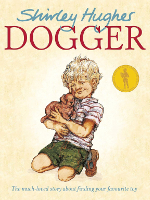 Dogger by Shirley Hughes (5K+)
Dogger by Shirley Hughes (5K+)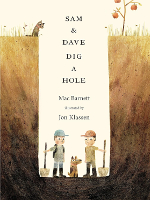 Sam and Dave Dig a Hole by by Mac Barnett and illustrated by Jon Klassen (5K+)
Sam and Dave Dig a Hole by by Mac Barnett and illustrated by Jon Klassen (5K+) “Wait for me!” Said Maggie McGee by Jean Can Leeuwen illustrated by Jacqueline Rogers (5K+)
“Wait for me!” Said Maggie McGee by Jean Can Leeuwen illustrated by Jacqueline Rogers (5K+) Katy and the Big Snow by Virginia Lee Burton (5K+)
Katy and the Big Snow by Virginia Lee Burton (5K+) Doctor De Soto by William Steig (1st+) This is often the book I read to the oldest classes.
Doctor De Soto by William Steig (1st+) This is often the book I read to the oldest classes. 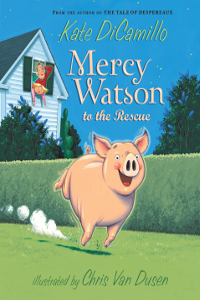 Mercy Watson to the Rescue by Kate DiCamillo illustrated by Chris Van Dusen (1st+)
Mercy Watson to the Rescue by Kate DiCamillo illustrated by Chris Van Dusen (1st+) 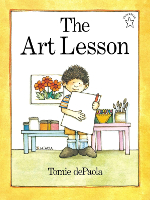 The Art Lesson by Tomie dePaola (1st+)
The Art Lesson by Tomie dePaola (1st+)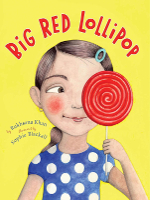 Big Red Lollipop by Rukhsana Khan and illustrated by Sophie Blackall (1st+)
Big Red Lollipop by Rukhsana Khan and illustrated by Sophie Blackall (1st+)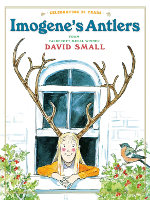 Imogene’s Antlers by David Small (1st+)
Imogene’s Antlers by David Small (1st+) Ox-Cart Man by Donald Hall and Barbara Cooney (1st+)
Ox-Cart Man by Donald Hall and Barbara Cooney (1st+) Strega Nona by Tomie dePaola (Also Bill and Pete) (1st+)
Strega Nona by Tomie dePaola (Also Bill and Pete) (1st+) The Day the Crayons Quit by Drew Daywalt and illustrated by Oliver Jeffers (1st+)
The Day the Crayons Quit by Drew Daywalt and illustrated by Oliver Jeffers (1st+)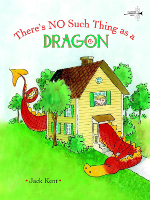 No Such Thing as Dragons by Jack Kent (1st+)
No Such Thing as Dragons by Jack Kent (1st+) The Red Carpet by Rex Parkin (1st+)
The Red Carpet by Rex Parkin (1st+) Sophie’s Squash by Pat Zietlow Miller and Anne Wilsdorf (1st+)
Sophie’s Squash by Pat Zietlow Miller and Anne Wilsdorf (1st+) Chrysanthemum by Kevin Henke (Also Lilly’s Plastic Purse) (1st+)
Chrysanthemum by Kevin Henke (Also Lilly’s Plastic Purse) (1st+) Cloudy With a Chance of Meatballs by Judi Barrett illustrated by Ronald Barrett (1st+)
Cloudy With a Chance of Meatballs by Judi Barrett illustrated by Ronald Barrett (1st+)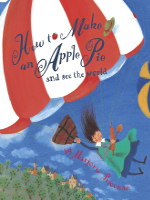 How to Make an Apple Pie and See the World by Marjorie Priceman (1st+)
How to Make an Apple Pie and See the World by Marjorie Priceman (1st+) Bring Me Some Apples and I’ll Make You a Pie: A Story About Edna Lewis by Robbin Gourley (1st+)
Bring Me Some Apples and I’ll Make You a Pie: A Story About Edna Lewis by Robbin Gourley (1st+) One Morning in Maine by Robert McCloskey (1st+)
One Morning in Maine by Robert McCloskey (1st+) The Story of Ferdinand by Munro Leaf and Robert Lawson (1st+)
The Story of Ferdinand by Munro Leaf and Robert Lawson (1st+) Imaginary Fred by Eoin Colfer and illustrated by Oliver Jeffers (Also Stuck by Oliver Jeffers) (1st+)
Imaginary Fred by Eoin Colfer and illustrated by Oliver Jeffers (Also Stuck by Oliver Jeffers) (1st+) Anatole by Eve Titus illustrated by Paul Galdone (1st+)
Anatole by Eve Titus illustrated by Paul Galdone (1st+) 100 Mighty Dragons All Named Broccoli by David LaRochelle and illustrated by Lian Cho (1st+)
100 Mighty Dragons All Named Broccoli by David LaRochelle and illustrated by Lian Cho (1st+) Salt in His Shoes: Michael Jordan in Pursuit of a Dream by Deloris Jordan , Roslyn M. Jordan, et al. (1st+)
Salt in His Shoes: Michael Jordan in Pursuit of a Dream by Deloris Jordan , Roslyn M. Jordan, et al. (1st+)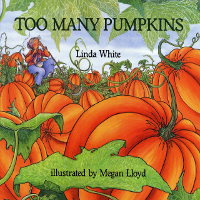 Too Many Pumpkins by Linda White and illustrated by Megan Lloyd (1st+)
Too Many Pumpkins by Linda White and illustrated by Megan Lloyd (1st+)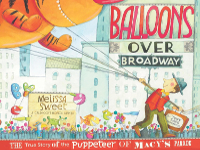 Balloons over Broadway: The True Story of the Puppeteer of Macy’s Parade by Melissa Sweet (1st+)
Balloons over Broadway: The True Story of the Puppeteer of Macy’s Parade by Melissa Sweet (1st+) The Three Billy Goats Gruff by Mac Barnett and illustrated by Jon Klassen (1st+ The key to this story is that children have already read the traditional version of the story, so they get the humor/ twist at the end of this one. )
The Three Billy Goats Gruff by Mac Barnett and illustrated by Jon Klassen (1st+ The key to this story is that children have already read the traditional version of the story, so they get the humor/ twist at the end of this one. )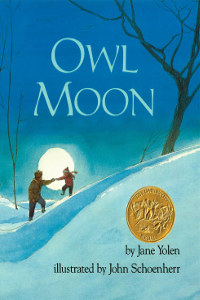 Owl Moon by Jane Yolen illustrated by John Schoenherr (1st+)
Owl Moon by Jane Yolen illustrated by John Schoenherr (1st+)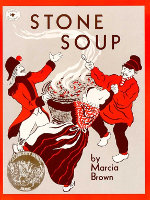 Stone Soup by Marcia Brown (1st+)
Stone Soup by Marcia Brown (1st+) Humphrey the Lost Whale: A True Story by Wendy Tokua and Richard Hall illustrated by Hanako Wakiyama (1st+)
Humphrey the Lost Whale: A True Story by Wendy Tokua and Richard Hall illustrated by Hanako Wakiyama (1st+) The Market Square Dog by James Herriot and illustrated by Ruth Brown (From James Herriot’s Treasury for Children ) (2nd +)
The Market Square Dog by James Herriot and illustrated by Ruth Brown (From James Herriot’s Treasury for Children ) (2nd +) The House on East 88th Street by Bernard Waber (2nd +)
The House on East 88th Street by Bernard Waber (2nd +) Miss Nelson is Missing by by Harry G. Allard Jr. illustrated by James Marshall (Also Miss Nelson is Back) (2nd+)
Miss Nelson is Missing by by Harry G. Allard Jr. illustrated by James Marshall (Also Miss Nelson is Back) (2nd+) Sylvester and the Magic Pebble by William Steig (2nd+)
Sylvester and the Magic Pebble by William Steig (2nd+)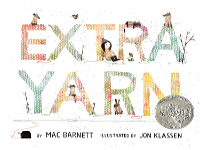 Extra Yarn by Mac Barnett and illustrated by Jon Klassen (2nd+)
Extra Yarn by Mac Barnett and illustrated by Jon Klassen (2nd+) Ira Says Goodbye by Bernard Waber (Also Ira Sleeps Over) (2nd+)
Ira Says Goodbye by Bernard Waber (Also Ira Sleeps Over) (2nd+) The Oldest Student by Rita Lorraine Hubbard and illustrated by Oge Mora (2nd +)
The Oldest Student by Rita Lorraine Hubbard and illustrated by Oge Mora (2nd +) Galimoto by Karen Lynn Williams and illustrated by Catherine Stock (2nd +)
Galimoto by Karen Lynn Williams and illustrated by Catherine Stock (2nd +)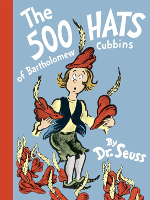 The 500 Hats of Bartholomew Cubbins by Dr. Seuss (3rd +) (*This book is very long! I have had younger classes really enjoy it as one of the last read-alouds of the year, but be prepared that it is 3 or 4 times longer than most of the other books on this list.)
The 500 Hats of Bartholomew Cubbins by Dr. Seuss (3rd +) (*This book is very long! I have had younger classes really enjoy it as one of the last read-alouds of the year, but be prepared that it is 3 or 4 times longer than most of the other books on this list.) Miss Rumphius by Barbara Cooney (3rd +)
Miss Rumphius by Barbara Cooney (3rd +) Real Cowboys by Kate Hoefler and illustrated by Jonathan Bean (3rd +)
Real Cowboys by Kate Hoefler and illustrated by Jonathan Bean (3rd +)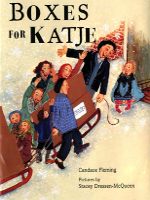 Boxes for Katje by Candace Fleming and illustrated by Stacey Dressen-McQueen (3rd +)
Boxes for Katje by Candace Fleming and illustrated by Stacey Dressen-McQueen (3rd +)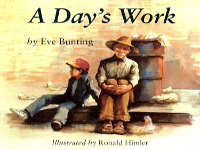 A Day’s Work by Eve Bunting and illustrated by Ronald Himler (3rd +)
A Day’s Work by Eve Bunting and illustrated by Ronald Himler (3rd +)
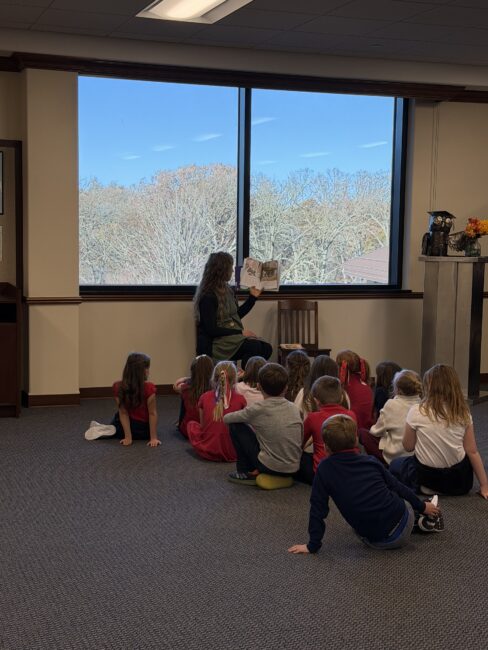
What books do you remember from library read-aloud time?
